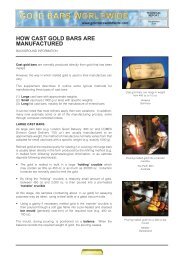Indian Gold Book:Indian Gold Book - Gold Bars Worldwide
Indian Gold Book:Indian Gold Book - Gold Bars Worldwide
Indian Gold Book:Indian Gold Book - Gold Bars Worldwide
Create successful ePaper yourself
Turn your PDF publications into a flip-book with our unique Google optimized e-Paper software.
TRADITIONAL JEWELLERY RETAILERS<br />
SIZE<br />
A relatively small number of retailers appears to account for a high proportion of gold jewellery sales<br />
nationwide.<br />
Although most retailers are cautious about revealing their own sales, and estimating the sales of their competitors, some<br />
general comments can be made.<br />
• There appear to be several thousand outlets nationwide that sell more than 300 g daily (on average during a year).<br />
Some outlets sell more than 1 kg daily. Many large retailers sell 50 times, some 100 times, as much as small outlets.<br />
• In most of the cities visited, the top 10% of outlets are reported to account for 50% or more of total jewellery sales.<br />
More than 50% of the total number of outlets in their cities are regarded as selling less than 50 g daily.<br />
• In the small towns and villages visited, although there can be large and dominant outlets in some, sales generally appear<br />
to be more evenly spread across many small outlets, most appearing to sell less than 50 g daily.<br />
Anecdotal evidence (at this time) suggests that a very high proportion (perhaps 75%) of the approximately 300,000 outlets<br />
in urban and rural areas sell less than 50 g daily, many less than 10 g.<br />
It also suggests that less than 15,000 large family retailers may account for as much as 30% or more of gold jewellery sales<br />
nationwide.<br />
METHODS OF PAYMENT<br />
Retailers accept payment in 3 forms: cash, old jewellery and coins/bars. The amount of old gold jewellery<br />
recycled is substantial.<br />
Although the sample of urban and rural retailers is small, the range and indicative typical amounts were recorded (as a<br />
percentage split) as follows.<br />
URBAN Range Indicative estimates<br />
Cash 40 - 85 70<br />
Old jewellery 5 - 60 25<br />
Coins/bars < 1 - 10 < 5<br />
Total 100<br />
RURAL<br />
Cash 30 - 80 60<br />
Old jewellery 20 - 70 35<br />
Coins/bars < 1 - 10 < 5<br />
Total 100<br />
Anecdotal evidence suggests that in 2001 the split nationally may have been approximately: cash (65%), old jewellery<br />
(30%) and coins/bars (less than 5%).<br />
Urban retailers observe that the amount of old jewellery exchanged has increased over the past 5 years. The proportion<br />
had risen for many from 15 - 20% to 25%.<br />
Most rural retailers indicate that the level of exchange is normally high, but tends to fluctuate according to local economic<br />
conditions.<br />
When visiting retailers in the west and south in May 2002, almost all reported that exchange had increased significantly due<br />
to the higher gold price, alongside a depressed economic environment. At times it had exceeded 50%.<br />
Old gold jewellery<br />
Old jewellery is exchanged mainly to buy new jewellery for marriage purposes, to replace worn-out jewellery, and to obtain<br />
fashionable new designs.<br />
Marriage jewellery. Although the wealthy tend to pay for new jewellery mainly in cash, the middle and lower classes tend<br />
to rely a lot more on the exchange of old jewellery accumulated over many years.<br />
Worn-out jewellery. As bangles, chains and earrings are usually worn on a daily basis, many customers exchange broken,<br />
dented and scuffed pieces. High caratage jewellery is prone to wear and tear.<br />
“Fashionable” jewellery. Exchanging items, even if bought only months or a few years previously, for new jewellery with<br />
fashionable new designs has grown significantly over the past 5 years, mainly by the high and upper middle classes.<br />
The amount of old gold jewellery exchanged can greatly influence the amount of gold imported, as well as annual estimates<br />
of the amount of jewellery fabricated and consumed.<br />
108<br />
AN INTRODUCTION TO THE INDIAN GOLD MARKET

















